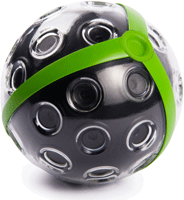Panono, the throwable 360-degree pano camera, enters crowd funding
posted Monday, November 18, 2013 at 2:57 PM EDT

Ever missed that once in a lifetime shot, and had to struggle not to throw your camera in dismay? Well, a new project over at crowd funding site IndieGoGo aims to have you throw your camera for a different reason: to take a photo. (Or more accurately, 36 of them.)
The Panono is a panoramic ball camera whose exterior is dotted with no less than 36 separate lenses, behind each of which sits a small 2-megapixel sensor. Throw it in the air, and Panono will automatically capture a full 360-by-360 degree spherical panorama at the moment when it reaches its heighest point, and so has the least motion. Since all 36 cameras shoot their photos simultaneously, there's no risk of duplicated subjects, as can be the case with multiple-shot panos captured through a single lens.
Panono's makers, who first gave a hint of their plans way back in October 2011, suggest that their creation solves a fundamental problem of consumer photography: that over time, you forget the world which surrounded your shot, and eventually, where the shot was even taking. By capturing a full spherical panorama, they contend, you get photos that tell the whole story. And if you don't want to throw the camera for an overhead view, you can also shoot with it mounted on a stick or handheld.
Since its YouTube debut in 2011 as the throwable panoramic ball camera, which we covered in our newsletter at the time, Panono has undergone a significant redesign, turning it from a cool concept into something which could actually be commercially produced. Gone is the complex, 3d-printed latticework body, replaced with a smaller, clear plastic shell that's about 4.3 inches (11cm) in diameter. Weight has been reduced significantly, as well, and is now less than half that of the early prototype at about 0.66 pounds (300g).
The electronics, too, have likely overhauled, although the basic format in terms of the number of cameras is unchanged. They're now cheaper to produce, and better suited to mass production. Panono's 36 cameras together capture 72 megapixels of data for each panorama, although after stitching is complete, the final output resolution will be rather lower. (No figure has yet been provided for output resolution.)
Panono will include a built-in, rechargeable battery that will recharge through a USB connection. Sufficient internal storage is built into Panono to capture around 400 panoramas, and data can be transferred wirelessly from the ball camera to Android 4+ or iOS 6+ devices using either Bluetooth or Wi-Fi. As well as data transfer, wireless settings adjustment will be possible, and you'll also be able to trigger the shutter remotely, should you choose not to throw Panono to capture a panorama.
As well as the time spent developing Android and iOS apps, the folks at Berlin-based Panono GmbH -- led by concept creator Jonas Pfeil -- have also been working on refining their stitching algorithms. There's still work to be done, though, as you can see in the example panoramas below, all of which were shot on the original prototype from 2011. (The newer, smaller design isn't yet functional.) The company's IndieGoGo project page characterizes stitching algorithm development as around 70% complete. Development is still needed in other areas, as well, including finalizing the electronics design, and that of the external shell.
With much yet to do, delivery of the final product for IndieGoGo backers isn't expected until September 2014 -- and that requires Panono to reach its funding goal. (Currently, around one-third of the necessary US$900,000 has been pledged, and the remainder is needed by January 4th, 2014 if the project is to go ahead.)
Cost may be an issue for the project, not surprisingly given its complexity, and the fact that 36 individual cameras are needed to assemble each Panono. The initial pricetag of US$549 is not exactly an impulse buy, with a small number of early-bird Panonos still remaining at a US$50 discount. No suggestion has been made of the product's final retail price, but past experience with projects on Kickstarter and IndieGoGo suggests it's usually the same or higher than the crowd-funded price.
Still, there's not a lot else out there which promises the same features. We've seen similar projects in the past, including Serveball's Squito and Darkball prototypes and Bounce Imaging's Explorer ball, but these either haven't reached retail themselves, or are available only for military / emergency services use. In the meantime, if you're willing to forgo the ability to throw your camera in the air, perhaps Ricoh's Theta 360 single-shot, spherical panorama camera would suffice. If not, check out the Panono website for more information, and pledge your money to back the project on IndieGoGo.